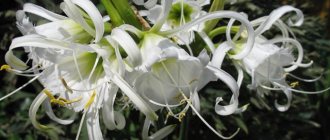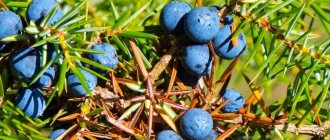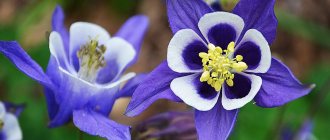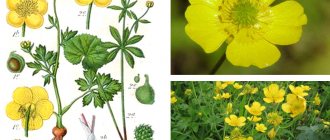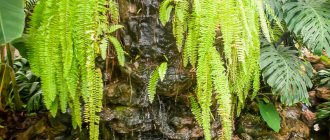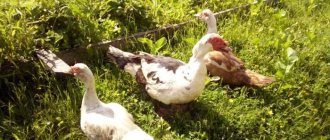Growing from seeds
The easiest way to grow this perennial flower in open ground is with seeds. The seeds are sown immediately in open ground or seedlings are grown from them.
Important! Both methods work effectively, so be guided by the climate in your region.
If you plan to grow seedlings first, then prepare the seeds for sowing in March. You need to start growing seedlings right at the very beginning of spring.
Soil and container
To grow Iberis seedlings you will need a large planting container or several small flower pots:
- Fill the planting container with nutritious and loose soil. As a substrate you can take a mixture of:
- peat with low clay content (15%);
- crushed perlite or compost bark (15%);
- garden soil (remaining volume).
- Distribute the seeds over the surface of the substrate, lightly sprinkle them with sand (1-2 mm), cover with glass or transparent film. Leave enough distance between the seeds to avoid picking in the future.
Important! Be sure to disinfect garden soil before adding it to the potting mix for planting.
How to care for seedlings?
Until the seedlings sprout, the shelter must be periodically removed and the seedlings under it ventilated. During such ventilation it is necessary to moisten the soil.
As soon as the first shoots appear, remove the film or glass completely. If you sowed the seeds too close to each other, then at this stage you need to pick. Thin the seedlings carefully, being careful not to damage the seedlings remaining for seedlings. Before planting in open ground, the seedlings must form a strong root system .
Gradually, it will be possible to take the seedlings outside to harden them. Gradually increase the time of seedling hardening. By the time they are planted in open ground, the seedlings should already be outside all day and not experience discomfort.
Planting seedlings
Iberis seedlings can be planted in open soil only after constant warm weather has established itself outside. Most often, you can do gardening in May:
- Prepare holes of the required size in advance. They should be located at a distance of approximately 13-15 cm from each other.
- Carefully remove the seedlings from the planting container along with the earthen ball. If you grew seeds in peat pots, you can plant seedlings with them.
- Place seedlings with a ball of earth in the holes, fill the voids with substrate and water the plantings.
Attention! If you are simultaneously planting several varieties of wallflower at once, then increase the distance between the seedling bushes. This will help avoid cross-pollination of plants.
Varieties of Iberis and their features
Today you can find more than 40 varieties of Iberis, but of all the varieties, perennial species are the most popular, since they are not afraid of frost and quickly adapt to any climate.
- Evergreens are small subshrubs with dense leaves and white umbrella-shaped inflorescences. If after the first flowering you constantly remove faded flowers, then Iberis will delight you with its flowering until the frost.
- Crimean - a spectacular plant that arrived from the peninsula has thick green leaves, purple inflorescences, which turn white after opening. It blooms in spring, loves warm climates, so does not tolerate cold weather.
- Gibraltar is a perennial plant variety with narrow leaves with lilac inflorescences, which over time change their color to white. In harsh climates, Iberis blooms only 2 times.
- Rocky - plant stems up to 15 cm high with a large number of cream or light pink flowers. Blooms for 1.5 months.
Note! Not all varieties of Iberis have a pleasant smell.
Sowing in open ground
Iberis can also be grown from seeds planted in open ground. But here it is important to take into account the climatic conditions of the growing region. The best time for landing is considered to be from May to June.
Deadlines
The timing for sowing perennial peppercorn seeds depends on the climate of your region.
- If you live in the south , where frosts are very rare in winter, then, in principle, you can sow even at the end of autumn, the flower will have time to take root and take root.
- If you live in temperate latitudes , where winters are most often harsh and cold, then it is better to play it safe and postpone the landing time to late spring, when the warmth has finally settled outside and the weather will not bring unpleasant surprises. Usually Iberis seeds are planted in May-early June, but some take risks and sow them at the end of April.
Choice of location and lighting
The pepper plant loves light, so you should choose an area for planting it that is open and sufficiently illuminated. Planting in partial shade will cause the plant to bloom sparingly (or even drop its buds).
Shaded areas will cause shoots to stretch out and the buds to wilt.
Choose areas with loamy, sandy or rocky soil . Please note that the substrate must be well-permeable to moisture and oxygen so that the roots of the plant do not rot from stagnation of water.
Sowing rules
The process of planting Iberian seeds in open ground:
- To begin, dig small holes, each 10 mm deep. The distance between planting holes should be approximately 20-25 cm (this takes into account the fact that the bushes will grow in the future). If you plant them too close to each other, then you will have to thin them later, and this is unnecessary stress for you and the plant.
- Pour the seeds into the holes, sprinkle a thin layer of soil on top and water the plantings.
If the air temperature by that time warms up to +19..20 degrees, then the first seedlings will appear within 7-10 days after planting.
How to root a seedling?
If you want to get an adult flower bush as soon as possible, you can buy an already mature seedling at a flower shop.
Attention! Be sure to carefully inspect the plant for diseases or other defects at the purchase stage.
All seedlings must be sold in a planting container. If the diameter of the container is 9 cm or less, then refuse to purchase such a plant. This means that its rhizome is not yet fully formed, so such a seedling is not suitable for planting in open soil.
Yellow or wilting leaf blades on a seedling are a sign of the presence of a disease. Only those plants whose leaves are elastic and green are suitable for purchase .
You need to plant the purchased seedling on the site together with the earthen ball with which you purchased it. This will help avoid damage to the roots. Prepare the holes in advance, then place the peppercorns in them, sprinkle the voids with soil and water the bush.
Description of Iberis
Iberis (iberis) is also called stennik, variegated, Iberian. Its stems are erect, branched, grow up to 30 cm, and in some varieties creeping. The leaf blades are elongated, smooth, shiny, dark green or bright green, 4-7 cm long, arranged alternately. The leaves are oblong or pinnately dissected, the edges are rounded.
During flowering, umbrella inflorescences form a snow-white cap, due to which the foliage is not visible and emit a pleasant, rich aroma. The palette of petals is mostly white, but pink, lilac, and purple are also found. They bloom in May, then in August, bloom for two months, annuals longer. When flowering, the diameter of the bush is 80-100 cm. Afterwards, a pod with small seeds is formed.
The root system is taprooted and consists of a main root and lateral ones. Because of this, the plant does not like transplanting.
How to care outdoors?
Caring for perennial Iberis is not that difficult. Even beginners in floriculture can cope with this. These plants are unpretentious; for their healthy growth and lush flowering, only a few simple rules are required.
Watering
In spring and summer, the pepper plant needs to be watered regularly . However, watering should be moderate. If there is a drought outside, the amount of watering can be increased slightly. But if it rains regularly outside, then additional moisture to the soil under the Iberis is not required.
Important! Under no circumstances should you overwater the plant. Waterlogging of the soil is detrimental to the wall plant; it leads to stagnation of moisture and rotting of the rhizome.
Feeding and fertilizer
Fertilizers for Iberis are rarely applied, only twice a year . Usually, at the beginning of the growing season, the plant requires a mineral mixture (Ammophos or Nitrophoska are suitable). After scheduled pruning in the fall, the plant receives additional nutrition with compost.
In the case of Iberis, you should not get carried away with fertilizers. When there is an oversaturation of fertilizers, the plant begins to grow greatly, the bushes lose their decorative shape, and the green part of the flower begins to prevail over the blooming part.
Pruning and shaping the bush
Wallflower needs regular pruning . It should be done when the bush grows too much. Only a third of the length of the shoot should be cut.
You should also remove buds that fade after flowering to make the plant look more decorative and neat. In addition, this procedure helps to stimulate re-blooming in August.
Attention! When preparing Iberis for wintering, the bush is cut to the base and then hilled up.
Blooming garden in the arms of Iberis evergreen
Every person is drawn to pristine nature throughout his life.
You can create it in your garden plot by planting Iberis evergreen. Since growing these flowers does not require much effort, in a short time the garden will be dressed in a thick flowering carpet. The pleasant aroma and cute flowers will delight gardeners from early spring until the beginning of the hot summer. Who wouldn't want to visit such a paradise? Of course, everyone. Other names for Iberis evergreen are wallflower, goldenflower or multipetal. It comes in both the form of an annual herbaceous plant and a perennial low-growing shrub. The plant was originally noticed in Spain, which in ancient times was called Iberia. Delicate flowers grew on the slopes of the majestic Iberian mountains. Externally, Iberis colonies resembled light fluffy clouds. Today, more than 3 dozen plant species are known.
Protection from pests and diseases
Wallwort can get sick for several reasons. One of the most common is waterlogging of the soil and, accordingly, infection with fungal infections. Most often the plant suffers:
- from powdery mildew;
- root rot;
- fusarium.
If the plant is already infected, it is better to dig it up and burn it immediately; it is unlikely to be saved. Be sure to treat the area where it grew with fungicides.
Sick plants should be burned away from other plantings to avoid contamination of healthy plants.
In order to prevent the spread of the fungus, the soil in which Iberis will be planted must be disinfected in advance.
Various pests are no less dangerous for peppercorns. Most often the flower is attacked:
- mealybug;
- ground fleas;
- cabbage aphid.
These parasites can be destroyed using a solution of potassium soap (150 g of soap per 10 liters of water). If the pests have firmly established themselves on the plant, then only insecticides can help, for example:
- Aktara;
- Fitoverm;
- Karbofos and others.
The treatment should be carried out twice: the first time when you notice parasites on the plant, and the second time 7-14 days after the first treatment.
Features of care
Growing perennial Iberis after planting it in the garden and caring for the plants is not difficult. Water it only during drought, so as not to create excess moisture on the root system.
Plants do not need fertilizing. If gardeners want to get lush flowering, they feed the Iberian plant with complex fertilizers twice in the summer and promptly remove wilted flowers.
After flowering, the stems are shortened by a third to give the bushes a neat appearance. Flowers of perennial Iberis, planted at least 5 years ago, with proper care, are replanted to keep its flowers large and its bushes lush.
You may be interested in:
Perennial flowers for a flower bed, blooming all summer: low-growing Along with annual flowers in a flower bed, summer residents always try to plant perennial flowers, and sometimes only...Read more...
Iberian shoots are planted directly into the ground in the warm spring, when all the frosts have passed. Usually this is May. In the garden, perennial Iberis needs a lighted area for planting, with suitable soil, and then care will be simple. The soil required is loamy, sandy, rocky.
After successful flowering, pods with seeds grow in place of the flowers. Due to the long flowering period, the pods ripen continuously and are collected as they ripen. Then they are dried in a warm place and the seeds are husked. Store seeds in a dry, cool place.
Many gardeners leave the pods unharvested in order to propagate the Iberian plant by self-sowing. With the first warmth of spring, friendly shoots appear at the site of last year's plantings, they are thinned out, and planted in a new place.
The perennial overwinters easily even in severe frosts. But when planting perennial Iberis at the dacha, caring for it requires covering it with spruce branches for the winter; the photo shows how the bush is pre-pruned and what part of it remains above the ground.
Remember!
Iberis is a frost-resistant plant, but when cultivated in central Russia, it requires winter cover with mulching.
Reproduction
You can propagate peppercorns in several ways:
- seeds;
- cuttings;
- dividing the bush.
The first method has already been described above. Now it’s worth talking about dividing and cutting the bush.
Cuttings
You need to prepare cuttings for propagation immediately after the end of flowering (this is approximately the end of August - beginning of September):
- Cut off the tops of already mature shoots. Each cutting should be 8-10 cm long.
- Plant the cut seedlings in planting containers filled with loose soil consisting of:
- peat;
- sand;
- leafy soil.
- Rooting of cuttings should be carried out in partial shade. Already in the fall, such shoots can be planted in open ground. However, if you live in a cold region where winters are harsh, then leave the cuttings in containers until the onset of warm spring.
Dividing the bush
It is easy to propagate Iberis by division:
- Around the end of March, you need to carefully dig up the mother pepper bush.
- Using sharp and disinfected garden tools, cut the bush into several pieces. Each part should contain one bud and part of the rhizome.
- Ready cuttings should be planted in containers with nutrient soil or immediately in open ground, covering them with polyethylene.
- As soon as 3 or more leaves appear on each bush, remove the cover.
- Plants that are grown in a container can be planted in open soil in August.
Autumn care, seed collection and wintering
The flowering of the pepper plant is quite long, so its seeds ripen in stages. They can be collected at different times as they ripen:
- Ripe seed pods need to be picked and then dried in a warm place.
- Then open each pod and remove the seeds from it. They will also need to dry a little.
- Place the seeds in a linen bag and store them in a dry and cool place (where the temperature reaches +10..+16 degrees). The storage location must have good air flow.
Some gardeners prefer not to collect seeds at all, since Iberis reproduces normally by self-sowing. In the spring, seedlings grown from seeds will only need to be thinned out.
After autumn pruning and fertilizing, it is best to cover the pepper plant for the winter , even though this plant is quite frost-resistant. Spruce branches and dry foliage are suitable for shelter.
Watering and loosening the soil
Dieffenbachia flower - home care
Shrubs need regular but moderate watering throughout the spring and summer. In hot and dry weather, watering increases proportionally. If there are no problems with precipitation in the region, then there is no need to water the plant.
Important! A large amount of liquid can cause rotting of the root system. Stagnation of moisture is a dangerous phenomenon for flowers.
Loosening of the soil is carried out as watering activities take place. At the same time, it is necessary to remove weeds, which under favorable conditions grow faster than cultivated plants.
Types and varieties: description and photo
Wallwort has many varieties and subspecies, but only a few species are used for cultivation in garden plots. The following are brief descriptions and photos of flower varieties.
Evergreen (sempervirens)
This subshrub, whose height reaches 32-42 cm, has been cultivated since the 17th century. The plant has oblong leaf plates, the length of which is 7-9 cm. The surface of the leaves is glossy, painted in a dark green shade. The inflorescences of this plant are umbrella-shaped, each with an average diameter of 5-6 cm. The flowers are white, each with a diameter of 15 mm. Flowering lasts approximately 21 days.
Popular varieties of the species:
- Dana;
- Zwergschneeflock;
- Findall.
Gibraltar (gibraltarica)
This subspecies belongs to the group of low-growing ones, since the height of the bush is 25 cm. The stems are branched, so the diameter of the plant can reach 42 cm. The leaf blades of the pepper plant are sparse, lanceolate. On the upper parts of the shoots, umbrella inflorescences, painted in white or pink shades, bloom.
Crimean (simplex)
The height of this subspecies is 9-10 cm. The leaf blades are blade-shaped, they are colored gray-green and have a small edge.
Unopened flowers are purple, but open flowers turn white.
Rocky (saxatilis)
An evergreen subspecies, whose height is 13-25 cm. Flowering begins at the end of April. The flowers are white.
Popular varieties:
- Hyacinthen Bluetige Risen;
- Pygmaea;
- Weiss Risen.
Easy to care for and elegant, Iberis can decorate any garden. Even a beginner can cope with growing this plant. You just need to follow a few simple rules that will allow you to grow a healthy and beautiful plant.
Brief information about Iberis
Iberis is an excellent ground cover plant. It can be either an annual or a perennial plant. In our country, the annual variety is most often grown. A member of the Cruciferous family.
By the way! Iberis has other names: Iberian, Stennik, Pepperper, Raznopetalka.
Popular types of this crop:
- Iberis umbelliferum is an annual plant, the most popular variety, most often grown in Russia. Blooms all summer.
- Iberis Gibraltar is a perennial crop with an interesting feature: at first the flowers are lilac in color, and then acquire a white tint (therefore this species is often called Chameleon).
- Evergreen is a perennial plant.
The height of the plant is on average 30-40 centimeters. The inflorescences resemble pretty umbrellas, reaching about 5-6 centimeters in diameter. Most often, Iberis inflorescences are white, but flowers of lilac, pink, and cream shades are also found.
In landscape design, the plant fits perfectly with stones. Therefore, it is suitable for growing on an alpine hill, in rock gardens. Just like other plants, it looks interesting and beautiful in border plantings (along garden paths or when edging a flower bed). It also looks good in bouquets when cut.
By the way, in addition to its decorative qualities, it has a delicate, subtle aroma.
With minimal care, Iberis will significantly transform your flower garden. It is completely unpretentious in care; any gardener can grow a plant and achieve lush flowering. The crop is drought-resistant, so it can be planted in hot and sunny areas of the garden. It grows well in the sun, but also tolerates light partial shade.
Prefers loamy soil, but it should be light and loose. Completely unpretentious in terms of soil nutrition. Does not tolerate dense, heavy soils.
The crop needs to be watered only in very dry and hot weather. To prolong flowering, it is necessary to trim off faded inflorescences.
Note! Iberis reproduces very well by self-sowing. Therefore, if you want it to grow independently throughout the area, then you do not need to remove the inflorescences. If you do not want to propagate yourself, then remove the inflorescences after flowering.
